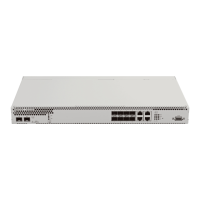MES3000 Ethernet switch series 13
Spanning Tree Protocol is a network protocol that ensures loop-free network
topology by converting networks with redundant links to the tree-like structure.
Switches exchange configuration messages, using the special format frames, and
selectively enable or disable traffic transmission to ports.
IEEE 802.1w Rapid
Spanning Tree Protocol
Rapid STP (RSTP) is the enhanced version of STP protocol that enables faster
network conversion to the tree-like topology and provides higher stability.
Layer 2 Protocol
Tunneling (L2PT)
Layer 2 Protocol Tunneling (L2PT) allows forwarding L2-Protocol PDU through a
service provider network, that provides transparent connection between client
segments of the network.
EAPS (Ethernet Automatic Protection Switching) is a protocol, that allows to avoid
traffic loops in the ring topology networks and enables fast restoration of traffic
flow after the failure in the specific network section. Restoration time provided by
EAPS is far less than in case of Spanning Tree protocols.
Ethernet Ring Protection
Switching
The protocol allows to increase stability and robustness of data network with ring
topology by decreasing the restoration time after the failure. Restoration time
does not exceed 1 second, that is substantially lower than the network
reconstruction in case of spanning tree family of protocols.
VLAN is a group of switch ports, that form a single broadcast area (domain). To
identify packets belonging to the specific VLAN, the switch supports different
means of packet classification.
GVRP (GARP VLAN
registration)
GARP VLAN registration enables dynamic adding/removal of VLAN groups on the
switch ports. If GVRP is enabled, the switch identifies and then distributes the
VLAN inherence data to all ports that form the active topology.
Distribution to VLAN groups is performed by the inbound ports. This solution
allows to use only one VLAN group on each port.
IEEE 802.1Q is an open standard, that describes the traffic tagging procedure for
transfer of VLAN inherence information. It allows to use multiple VLAN groups on
one port.
Link aggregation with
LACP
LACP enables automatic aggregation of separate links between two devices
(switch-switch or switch-server) in a single data communication channel.
Protocol constantly tries to find ways for link aggregation; in case of link failure in
the aggregated channel, its traffic will be automatically redistributed to
functioning components of the aggregated channel.
MES3000 devices support link group creation. Link aggregation, trunking or IEEE
802.3ad is the technology that enables aggregation of multiple physical links into
one logical link. This technology allows to increase the bandwidth and reliability of
the backbone 'switch-switch' or 'switch-server' channels. There are three types of
balancing—based on MAC addresses, IP addresses and the destination port
(socket).
LAG group contains ports with the same speed, operating in full-duplex mode.
Allows to identify voice traffic by OUI (Organizationally Unique Identifier—first 24
bits of MAC address). If MAC address with VoIP gateway or IP phone OUI exists in
the MAC table of the switch, this port will be automatically added to voice VLAN
(identification by SIP protocol or destination MAC address is not supported).
Allows to assign external VLAN SPVLAN (Service Provider's VLAN) based on
configured filtering rules by internal VLAN numbers (Customer VLAN). Selective
Q-in-Q allows to break down subscriber's traffic into several VLANs, change
SPVLAN tag for the packet in the specific network section.

